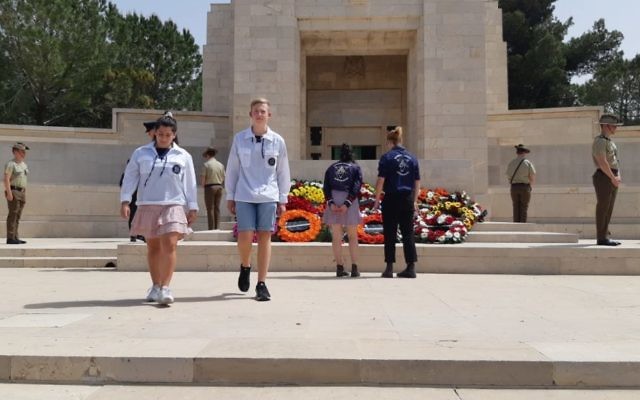Anzac Day in Israel: honouring their sacrifice
AS Israelis remembered the horrors of the Holocaust on Yom Hashoah this week, Australians offered a reminder of how much the world has changed.
AS Israelis remembered the horrors of the Holocaust on Yom Hashoah this week, Australians offered a reminder of how much the world has changed.
German representatives laid wreaths alongside those of Britain, Australia and others who their country fought against in two world wars.
Israel’s Anzac Day service, which was delayed until this week because of Passover, ended with music ringing out over the Jerusalem War Cemetery on Mount Scopus. Representatives of the once-warring countries stood together through the Last Post – uniformed men and women saluting – and through the anthems of New Zealand and Australia.
They also stood through Hatikvah, the anthem of a state that didn’t exist when those countries were locked in conflict. Soldiers from the IDF gave the most rousing renditions in the cemetery.
Australia’s ambassador to Israel, Chris Cannan, conveyed a unifying message when talking about the Anzac legacy. “Remembering Anzac Day is, of course, not about glorifying war,” he said. “It is about remembering, and honouring, the sacrifice of fellow countrymen and women who put their lives on the line for something larger than themselves – our nations, our interests and our values.”
The event, organised by the Australian embassy in Tel Aviv and attended by 200 people, didn’t only showcase harmony between countries that clashed in the past, but also faiths that clashed in the past. There was a call to worship and a blessing from a Christian reverend who lives in a Palestinian neighbourhood of Jerusalem, Angleena Keizer, and a psalm from a rabbi who made aliyah from Sydney to Jerusalem, Raymond Apple.
After the service, as most of the crowd headed for refreshments, a small group went with Rabbi Apple to some Jewish graves, for a short sermon and the Kaddish prayer, which everyone recited together. Surprisingly, Rev Keizer went along, and stood respectfully taking in the scene.
“I just couldn’t walk away and go for refreshments,” she told me. “I felt I needed to remember these Jewish soldiers.”
Rev Keizer is based at the Church of Scotland in Jerusalem, and spends much of her time working with Palestinians. She said that she has been keen to take part in events that bring people together around the past ever since her very unusual route to school.
Though she is British she grew up in Germany, and on her way to school every day passed Bergen-Belsen. “When we were teenagers my father actually took us into Belsen, and it has affected me ever since. From then on I’ve had a passion for living with peace between people of all faiths and none.”
Rabbi Apple drew on a Passover theme in his sermon, suggesting that the Jewish people may have said “dayenu” – it would have been enough – had they survived the 20th century. “But God also made it possible to have a State of Israel, fulfilling the hopes of many generations.”
Rabbi Apple also took up the theme of unity between peoples in his closing message, expressing hope that “we will be able to see what the boys buried here never got to see – a region of peace”.
Cannan spoke about the life of Eliazar (Lazar) Margolin, who was born in Russia in 1875 to a Jewish family, migrated to Palestine in 1892 and moved to Australia 10 years later.
At the age of 39, Margolin joined the Australian Imperial Force’s (AIF) 16th Battalion in October 1914. He was among the first of his battalion to land on Gallipoli. In September 1915, Major Margolin took temporary command of the battalion and played an instrumental role during the evacuation of Gallipoli. He was awarded the Distinguished Service Order for his efforts.
He was wounded in 1916 but upon recovery, he commanded a battalion in the British Army’s Jewish Legion which fought alongside the Anzacs in Palestine. Cannan said that Margolin’s life story “represents ideals that go beyond time and place. It tells a larger story about the forging of our respective national characters and identities during those fateful years”.
“He embodies the Anzac characteristics of resilience, leadership and mateship. Lazar Margolin’s life also demonstrates a shared history and the close links dating back to over a century ago.”
The Margolin legacy, and other strands that connected the Anzacs and the Israel story, were inspiring to many of the 100-plus Australian gap year students, from various different movements in attendance. Nicky Retman, an 18-year-old from Hineni in Melbourne, said that marking Anzac Day in Israel, in the middle of the season of Israeli memorials such as Yom Hashoah and Yom Hazikaron, made her feel a “strong connection” to the various commemorations.
“To be in Israel and commemorate Anzac Day together with fellow Australians and Israelis is an experience I will never forget,” she said. “It was an honour to have been part of the ceremony and represent my youth movement and my country in my homeland.”
NATHAN JEFFAY


comments